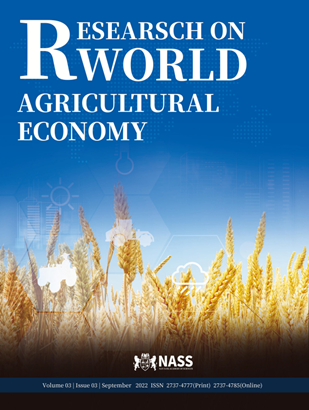Economics of Pulse Production in Bundelkhand Region of Uttar Pradesh, India: An Empirical Analysis
Prabhakar Kumar
Division of Agricultural Economics, ICAR-Indian Agricultural Research Institute, New Delhi, India
Ankhila R. Handral
Division of Agricultural Economics, ICAR-Indian Agricultural Research Institute, New Delhi, India
ICAR-National Rice Research Institute (NRRI), Cuttack, Odisha, India
R. K. Yadav
College of Agriculture, Lakhimpur Kheri Campus, C.S. Azad University of Agriculture & Technology, Kanpur, India
P. Anbukkani
Division of Agricultural Economics, ICAR-Indian Agricultural Research Institute, New Delhi, India
DOI: https://doi.org/10.36956/rwae.v3i3.560
Received: 19 June 2022; Received in revised form: 11 July 2022; Accepted: 19 July 2022; Published: 5 August 2022
Copyright © 2022 Prabhakar Kumar, Ankhila R. Handral, Biswajit Monda, R. K. Yadav, P. Anbukkani. Published by Nan Yang Academy of Sciences Pte. Ltd.
 This is an open access article under the Creative Commons Attribution-NonCommercial 4.0 International (CC BY-NC 4.0) License.
This is an open access article under the Creative Commons Attribution-NonCommercial 4.0 International (CC BY-NC 4.0) License.
Abstract
The Bundelkhand region contributes more than half of the total pulse area of the Uttar Pradesh state but the productivity is below the state average, which calls for various technological interventions, development of infrastructure and marketing strategies. This study assessed the profitability of pulse cultivation, identified the constraints and suggested policy measures using the data collected during 2016-2017 from 100 pulse growers selected from two backward districts of the Bundelkhand region, namely Jalaun and Hamirpur. Growth in area, production and yield was estimated using data for 1980-2015 through compound annual growth rate and the highest growth was observed during the 1980-1990 period. Modern cost concepts were used to assess the profitability of pulse cultivation and results revealed that the cost of cultivation per hectare was significantly higher in pigeon peas in comparison to gram, pea and lentil crops. The marketing charges paid by the village trader, wholesaler and retailer ranged between INR 20 to INR 40 per quintal for different crops. It was also observed that the quantum of marketable surplus and its percentage share to total production in pigeon peas, gram and lentils increased with the increase in the size of land holding. The pulse production in the region is faced with constraints related to production, processing and marketing. Hence, technologies and infrastructure need to be embraced through suitable policies to favor farmers, so as to maintain balance and keep the interest of both producers and consumers.
Keywords: Bundelkhand, Cost of cultivation, Marketable surplus, Pulse production
References
[1] Alexandratos, N., Bruinsma, J., 2012. World Agriculture towards 2030/2050 [Internet]. Rome: FAO. Available from: https://www.fao.org/3/ap106e/ap106e.pdf
[2] Inbasekar, K., Roy, D., Joshi, P.K., 2015. Supply-side dynamics of chickpeas and pigeon peas in India [Internet]. New Delhi: South Asia Office. Available from: https://www.ifpri.org/publication/supply-side-dynamics-chickpeas-and-pigeon-peas-india
[3] Jukanti, A.K., Gaur, P.M., Gowda, C.L.L., et al., 2012. Nutritional quality and health benefits of chickpea (Cicer arietinum L.): A review. British Journal of Nutrition. 108(S1), S11-S26.
[4] Directorate of Economics and Statistics, Department of Agriculture, Cooperation and Farmers Welfare, Ministry of Agriculture, Government of India; 2019 [Internet]. [cited 2022 Jan 5]. Available from: https://eands.dacnet.nic.in
[5] Directorate of Economics and Statistics, Department of Agriculture, Cooperation and Farmers Welfare, Ministry of Agriculture, Government of India; 2021 [Internet]. [cited 2022 Jan 6]. Available from: https://eands.dacnet.nic.in
[6] Katiyar, M., 2007. Improved varieties of pulses for Uttar Pradesh. Kanpur: Azad University of Agriculture and Technology.
[7] Directorate of Economics and Statistics, Department of Agriculture, Cooperation and Farmers Welfare, Ministry of Agriculture, Government of India; 2018 [Internet]. [cited 2022 Jan 5]. Available from: https://eands.dacnet.nic.in
[8] Singh, S.K., Praharaj, C.S., Singh, L., 2012. Farmers participatory approach in seed multiplication of pulses in Bundelkhand region: A case study. Journal of Food Legumes. 25(4), 330-333.
[9] Samra, J.S., 2008. Report on Drought Mitigation Strategy for Bundelkhand Region of Uttar Pradesh and Madhya Pradesh [Internet]. Inter-ministerial Team, New Delhi. Available from: https://www.un-spider.org/sites/default/files/5-Drought_Mitigation_National%20Rainfed%20Area%20Authority_India.pdf
[10] Mondal, B., Singh, A., Sekar, I., et al., 2016. Institutional arrangements for watershed development programmes in Bundelkhand region of Madhya Pradesh, India: An explorative study. International Journal of Water Resources Development. 32(2), 219-231. DOI: https://doi.org/10.1080/07900627.2015.1060195
[11] Sah, U., Dixit, G.P., Kumar, N., et al., 2021. Status and strategies for development of pulses in Bundelkhand Region of India: A review. Legume Research. DOI: https://doi.org/10.18805/LR-4518
[12] Singh, S., Nayak, S., 2020. Development of sustainable livelihood security index for different agro-climatic zones of Uttar Pradesh, India. Journal Of Rural Development. 39(1), 110-129. DOI: https://doi.org/10.25175/jrd/2020/v39/i1/125991
[13] Palsaniya, D.R., Singh, R., Tewari, R.K., et al., 2008. Socioeconomic and livelihood analysis of people in Garhkundar-Dabar watershed of central India. Indian Journal of Agroforestry. 10, 65-72.
[14] Mondal, B., Singh, A., Singh, S.D., et al., 2017. Augmentation of water resources potential and cropping intensification through watershed programs. Water Environment Research. 90(2), 101-109. DOI: https://doi.org/10.2175/106143017X14902968254700
[15] Alam, N.M., Adhikary, P.P., Jana, C., et al., 2012. Application of Markov model and standardized precipitation index for analysis of droughts in Bundelkhand Region of India. Journal of Tree Sciences. 31(1&2), 46-53.
[16] Ahmed, A., Deb, D., Mondal, S., 2019. Assessment of rainfall variability and its impact on groundnut yield in Bundelkhand Region of India. Current Science. 117(5), 794-803.
[17] Gupta, A.K., Nair, S.S., Ghosh, O., et al., 2014. Bundelkhand Draught: A Retrospective Analysis and Way Ahead [Internet]. National Institute of Disaster Management. Available from: https://www.preventionweb.net/publication/bundelkhand-drought-retrospective-analysis-and-way-ahead
[18] Raju, V.T., Rao, D.V.S., 1990. Economics of farm production and management. Oxford and IBH Publishing Co. Pvt. Ltd.: New Delhi.
[19] Nirmala, B., Muthuraman, P., 2009. Economic and constraint analysis of rice cultivation in Kaithal District of Haryana. Food Research & Development. 9(1), 47-49.
[20] Merga, B., Haji, J., 2019. Economic importance of chickpea: Production, value, and world trade. Cogent Food & Agriculture. 5(1), 1615718. DOI: http://dx.doi.org/10.1080/23311932.2019.1615718
[21] Government of India, 2015. Directorate of Economics and Statistics, Department of Agriculture, Cooperation and farmers’ Welfare, Ministry of Agriculture and Farmers' Welfare. Available from: http://eands.dacnet.nic.in
[22] Wood, J.A., Grusak, M.A., 2007. Nutritional value of chickpea. Chickpea Breeding and Management. DOI: http://dx.doi.org/10.1079/9781845932138.005





